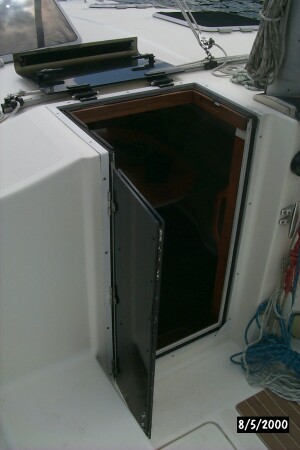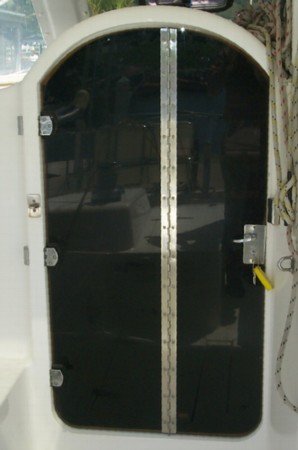How the early Escale companionway design
weakened our Prout Catamaran
Our old 37' Prout Snowgoose had a oval companionway cutout similar to the pressure doors found on submarines. While this entry was not incredibly comfortable, we could rely on the strong frame around the door entry to keep the seas and the weather out while causing little weakness in the hull. The oval shape is nice because a rounded shape will concentrate stresses far less than square corners. This is of particular importance to designs incorporating non-isotropic materials like fiberglass where the fibers are aligned with anticipated stresses.
The "L" shaped companionway opening in the early Escale series caused incredible flexing in the hull. The toroidal stiffness of the boat frame was gone as the monocoque the designers depended upon in previous designs had been breached. Joints were opening and closing ¼" in moderate wave action as the two hulls flexed in different directions. Luckily, several reviewers noticed this defect and spurred Prout Catamarans into remedial action. After all, how are you going to sell other people on a boat design that is literally falling to pieces in front of them?
Prout Catamarans eventually retrofitted a stiffening beam across the saloon roof which stopped the most obvious joint action. Subsequently, Prout abandoned the L-shaped companionway opening in favor of the older, more robust design. The only modernization was the acrylic "bubble" they placed in front of the door frame.
Early Companionway
The early Escale series "L" shaped companionway: Upper part of door folds onto deck, other section folds to the side with piano hinges. Result: a very large entry into the saloon with no stooping. The upper section has two locks and two levers to hold it in place. |
Later Companionway
Fellow Prout owner Bill Turner sent along this picture of a "current" companionway. Note the arch at top - it starts in the same location as where our "L" makes its way forward. Many thanks! |
Our "sport"-model mast was blamed for the flexing when the actual culprit was the trial-by-error approach that Prout took to the design and construction. It's not like we insisted on putting on a longer mast - this was an OEM option that we paid good money for.
Lesson learned: Always insist on a independent and reputable marine survey when purchasing - even for a new boat. Sea trials in nasty conditions are a must as these will illustrate better than anything how the boat handles adversity. Then make acceptance of the boat dependent on a satisfactory survey. Place the money in escrow just in case things do turn ugly. Otherwise, you have little leverage when your investment falls to pieces before your eyes through no fault of your own.
In our case, Prout catamarans repaired the flexing of the hulls but not the resultant, obvious damage throughout our Escale. As the following pages will show, the boat has suffered extensive damage in several areas that have taken a lot of elbow grease and expense to fix. Yet, was this really necessary? Couldn't Prout Catamarans have discovered the failure of their design in the first boat off the line and spared ours the agony it went through? Somehow, the other boatbuilding companies manage to do this.
Best Estimate of Time Required:
| Sail boat, notice action, document, correspond w/Prout re: fixes | 24 hours |
|---|---|
| Install stiffening beam across saloon roof | Done by Prout |
| Total | 24 hours |
|---|

